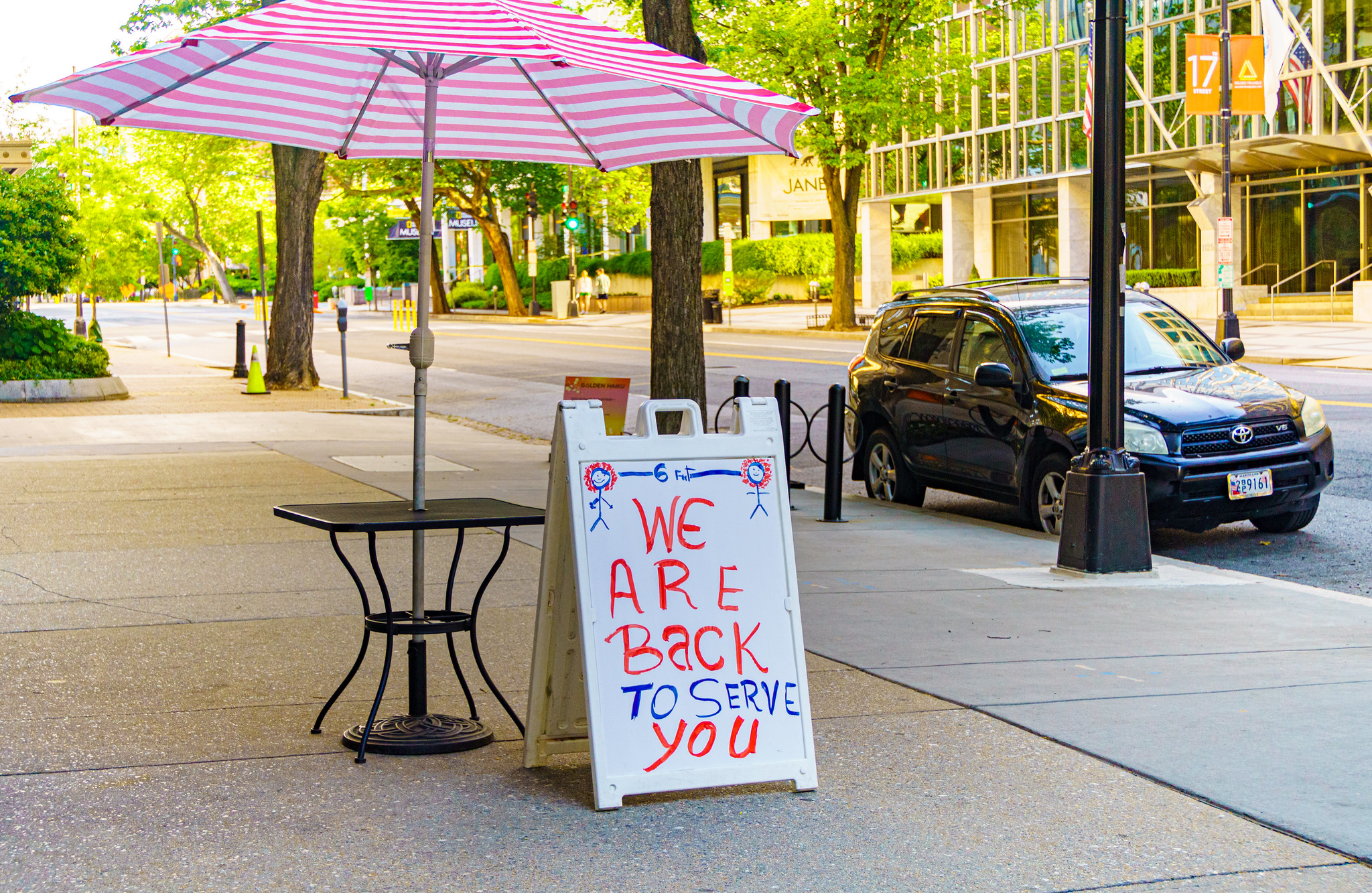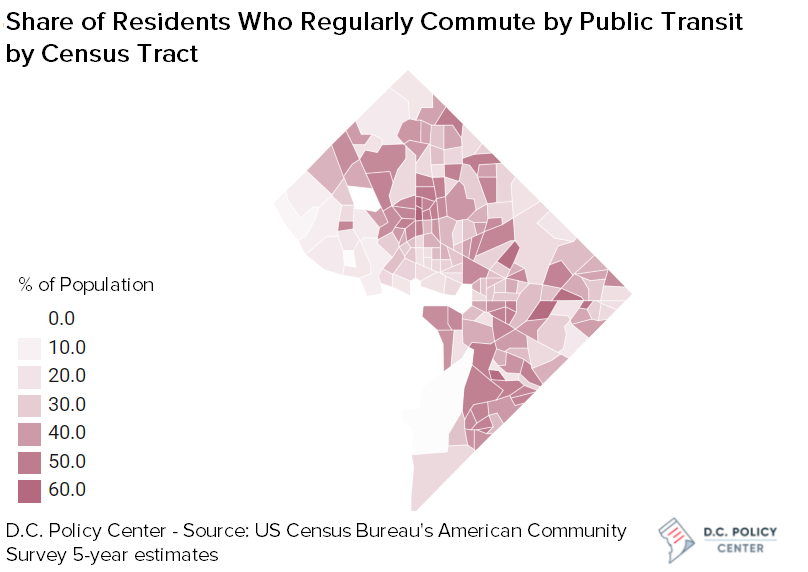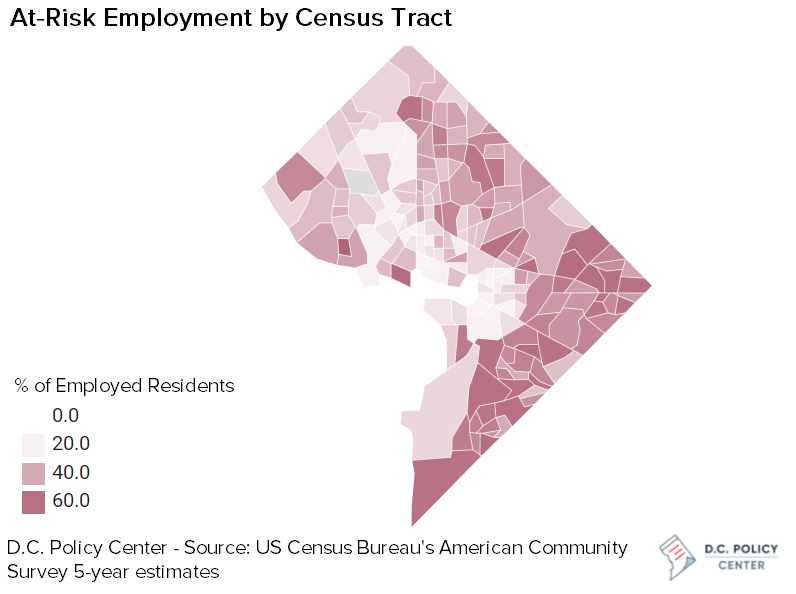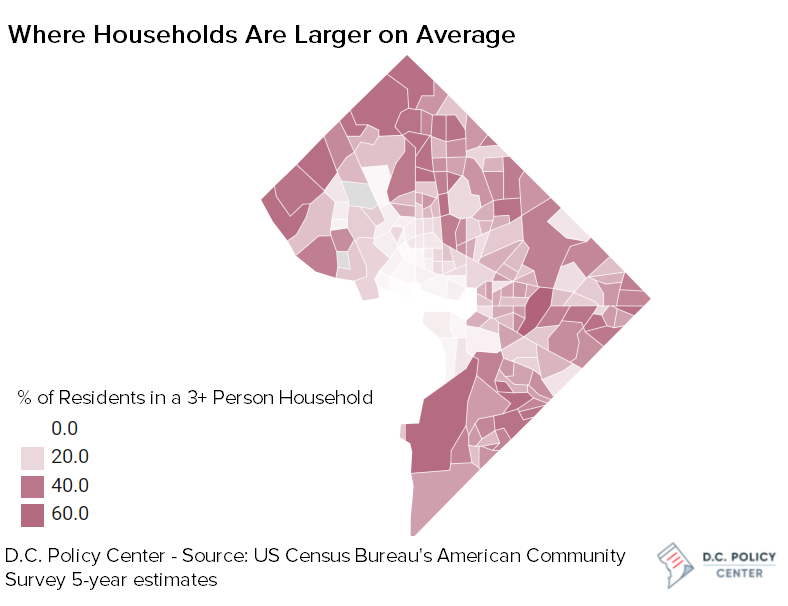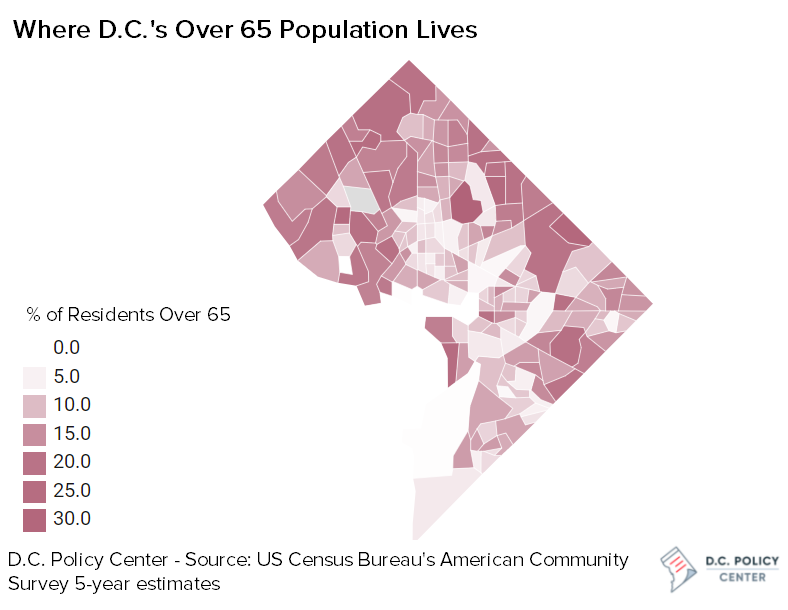Both during and after, the COVID-19 pandemic is going to widen existing inequities in Washington, D.C.
Despite the heavily repeated mantra that pandemics are “a great equalizer” that we all must face together, mounting evidence confirms that infection and death rates are anything but equal. Per capita, the number of COVID-19 cases in D.C. varies greatly by neighborhood. While Georgetown has only around 2 positive cases per thousand residents, neighborhoods with a higher share of minority residents, like Saint Elizabeths, Lincoln Heights, and Petworth, have more than 10 positive cases per thousand residents. Discrepancies for fatality rates are even greater. What’s perhaps even scarier is that the underlying inequalities in health, wellbeing, and economic outcomes may get worse as the District begins to reopen in the coming weeks or months.
Workers reliant on public transit will be more exposed to COVID-19
As businesses begin reopening and teleworking organizations reopen their physical offices, how people will commute to work is a significant public health and economic concern. Even with subsidies, public transit needs high-density ridership to be financially feasible. This high-density ridership has already caused trouble for public transit employees. Over 78 New York City Transit Authority workers have died from COVID-19 already, and a New York Times analysis puts public city bus drivers in the 78th percentile for jobs with the most physical contact exposure. 81 of the D.C. Metro’s own employees have also tested positive for COVID-19.
Disadvantaged communities will not easily be able to adjust their commutes when they start to return to work, and will likely need to continue to rely heavily on public transit. The American Public Transportation Association estimates that around 60 percent of riders taking public transit in the United States do not have access to a private vehicle that they could use to make that same trip. And their commutes will be harder. To maintain social distancing guidelines on a rail car meant for 100 people, Metro authorities estimate only about 20 people could ride at one time. If implemented, these social distancing strictures will add time and uncertainty to commutes, and may dissuade some workers from returning back to work, adding to economic distress.
The map below shows which areas of D.C. had the highest share of workers commuting by public transit before COVID-19, and is just a first look into where transit-dependent residents live. The graphs in this article use data from the US Census Bureau American Community Survey’s five-year estimates. Since they are estimates, they have high margins of error (around 5-10% in each census tract), so they are meant to show general trends by region rather than specify exact at-risk census tracts.
While these realities are harsh and difficult to combat, WMATA has taken steps to mitigate them by adhering to higher cleanliness standards, promoting social distancing on the Metro, and preparing the service for the difficulties it will face during reopening.
Sector of employment will continue to affect exposure
Where in the economy residents work will likely matter even more than how they get there. What sector of employment residents work in matters both because of how contact-heavy the profession is, thus raising the potential of exposure to COVID-19, and how much flexibility workers have in continuing to work from home after D.C. begins reopening. Professions in the accommodation and food service, retail trade, education, and healthcare and social assistance industries have more than double the COVID-19 risk scores compared to less contact-heavy professions like Bookkeepers and Web Developers. From 2017 to 2018, over half the employees in the financial activity (57 percent), professional and business service (53 percent), and information (53 percent) industries reported being able to work from home. In the same Bureau of Labor Statistics survey, just 9 percent of those employed in leisure and hospitality, 17 percent in retail trade, and 26 percent in education and health services reported having that same privilege.
The distribution of where D.C. residents who work in these more at-risk industries live is geographically uneven. Below is a map by census tract of where D.C. residents are more reliant on jobs in the retail trade, education service, health and social assistance, and accommodation and food service industries.
Census tracts east of the Anacostia River and with larger minority populations have a far greater reliance on higher risk and more contact-heavy professions. Wards 7 and 8 have median household incomes of just $41,000 and $37,000 respectively, well below the District’s $90,000 median household income.
These income and employment differences mean that workers in Wards 7 and 8 not only will return to industries where they will be more exposed to COVID-19 and less able to work from home, but that they will also likely need to return to work earlier (if they haven’t already as essential workers) because of greater financial need.
Access to healthcare
Access to healthcare is also a complex issue. Healthcare access in D.C. varies greatly, as does access to pharmacies, health disparities, and even access to food. Racial and ethnic minorities groups have already been hit harder by COVID-19, and the District’s own prior health disparities could be expanded post reopening.
Insurance coverage variations also means regions of the city with lower insurance rates could be hit harder by the massive medical bills that can accompany COVID-19 treatment, causing longer economic recoveries for some residents.
Household size and exposure risk
Household size differences are another area where inequality will affect COVID-19 exposure both before and after reopening. Exposure between members of the same household has been one of the strongest causes of COVID-19 transmission, with household attack rates as high as 17 percent in some studies, compared to a general attack rate of less than 7 percent (attack rates refer to the percentage of an infected person’s contacts who contract the virus). In the District, Wards 4, 7, and 8 have the highest median household sizes (of about 2.4 people compared to the District median of 2.07). These larger households, especially those with children who may return to school in the fall, will struggle with more points of contact and more difficulty in social distancing.
Age risks
While not as large of a factor in contracting COVID-19, age so far has played a role in survival rates. Older individuals are far more likely to have severe and deadly cases of COVID-19. Neighborhoods with higher concentrations of older citizens, such as Chevy Chase (where nearly 21 percent of residents are over 65 compared to just 13 percent city-wide), could end up needing more healthcare support post-reopening.
COVID-19 will play a role in D.C. for years to come
With mounting economic damage, the national pressure to reopen states and cities is undeniably growing.
While many states and the White House have rushed to reopen with vague plans, the District, led by Mayor Bowser, has been far more direct in recognizing the difficulties COVID-19 will cause for the city long after reopening. The Mayor’s reopening task force has included experienced public officials, WMATA has taken numerous steps to curb potential COVID-19 exposure on the region’s trains and buses, and the Mayor has continued to rely heavily on the advice of scientists and public health experts.
When the District does begin to reopen, recovery will not look the same across neighborhoods. Residents of lower income wards will likely face greater potential exposure to COVID-19 as they return to more contact-heavy professions and regular public transit use. Lower-income workers bearing the brunt of economic turmoil will likely need to return to work sooner, and those without proper healthcare access will continue to suffer harder from COVID-19.
In the end, even with the best designed of reopening policies, COVID-19 is going to continue to play a role in the inequalities that exist in the District for years to come.
About the data
The analysis presented here largely relies on the American Community Survey 5-year data summaries for 2013-18. The definition of at-risk employment is adapted from the World Economic Forum’s at-risk employment research. The maps have been created using Datawrapper.
DC Neighborhoods classification for reference: https://drive.google.com/file/d/1GBX_VEtu4wdS4YN2cllPLClv5SU7XSnS/view
